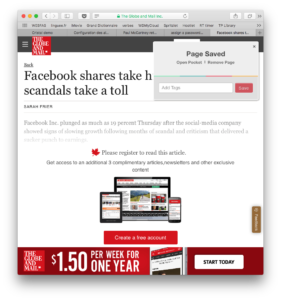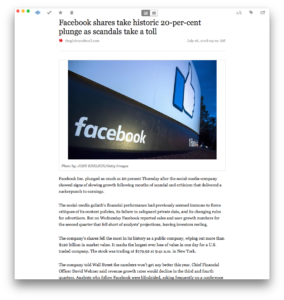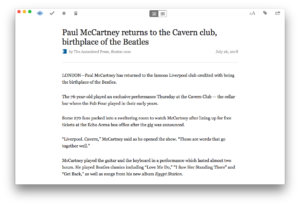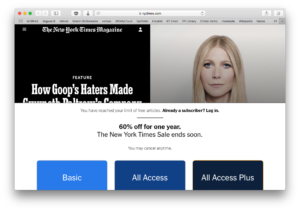News websites need to make money, so they ask readers for subscriptions. These subscriptions seem reasonable and I suspect many news junkies (sorry, readers) pay for them.
My relationship to news websites
I’m doing what I can to avoid the news in general. As an old New Yorker cartoon caption stated: “My desire to stay in formed conflicts with my desire to stay sane.” So I don’t subscribe to any news websites.
Still, I like to read articles from time to time. I get up to five free articles a month from certain news sites. After that, I see teaser headers and a subscription offer. (There are workarounds to this limitation, but I don’t care enough to use them regularly. It’s a time-wasting hassle that doesn’t pay off, IMHO.)
Pocket – offline reading
I also use free software called Pocket to save web pages (like articles) for offline reading when I have time to read them.
When I think about it, Pocket is robust software. Read below about some of the useful things it does, both obvious and less so.
Saving articles
In my desktop browser, I click the Pocket toolbar button. In my iOS browser, I touch the Share icon, then the Pocket icon. It’s that easy. Articles get synced to the Pocket application on each device I installed the application on.
Reading articles
I read content in white text on a black background, which makes reading before bed less likely to keep me up at night. (I don’t have difficulty dropping off to sleep, but for those who do, looking at screens before bed is not supposed to be helpful, given reports I’ve read on the topic.)
Listening to articles
Pocket also features text to speech (TTS) so I can hear the article read back to me at the speed I choose. In other words, I can treat saved articles like podcasts, doing other things as I hear them read out loud.
Sharing articles
I can also share pages on my social media accounts directly from Pocket.
Penetrating paywalls – the accidental discovery
One day, I casually put two and two together. I used Pocket on an article behind a paywall. The website? TheGlobeAndMail.com. Guess what? I downloaded the full text of the article to Pocket.
Here’s what the article looks like in a web browser, along with the Pocket confirmation message in the top right corner:

And here’s what it looks like in Pocket (yes, it downloaded the full text).

This doesn’t work on all websites, but it does on other big media sites.
Here’s an example from the Toronto Star. As with the Globe and Mail example above, the website blurs everything below the first few lines.

And here’s what I downloaded to Pocket.

And here’s one from the New York Times – the article behind the paywall:

and the full article in Pocket (it’s a great read, by the way, as is so much on nytimes.com)

I successfully used this trick on sites like those for Wired Magazine and The Economist before I stopped my casual experiments. This tells me the flaw runs across different paywalls.
Why am I telling you this?
I have three reasons for writing this post. None of them have to do with wanting to be a scofflaw or encouraging you to do the same (though I will suggest you do so).
1. It’s a tech tip
I like sharing cool technology insights and tools of all kinds.
2. News organizations ought to protect their revenues
When I tweet this post, I’m going to tag the media outlets I’ve mentioned here so that their webmasters may learn of this hole in their paywalls (if they don’t already know). If you find other news websites that are vulnerable to this workaround, please tweet the post to them too.
I’d rather see reputable media outlets earn every last cent they can. Today more than ever, independent, professional media must thrive to help society stay on the rails.
3. Readers may as well use these holes in paywalls
Large organizations may not be able to fix these leaks quickly. Until they do, I will use this tip to continue to occasionally download behind-the-paywall article. You may as well too. Maybe media organizations will start to measure the lost revenue from these leaks, and if the numbers warrant, they will fix these faults more quickly.
Paywalls aren’t perfect
I’m not naive. Paywalls must have holes other than Pocket and the one I alluded to above. I found these openings without putting forth much effort. People who look for such vulnerabilities must know of others.
What easy-to-exploit holes have you found in paywalls? Let me know in the comments below. Your answers may cut off “free” access to things you value today, but they may help preserve the creators of those things tomorrow.
Please think long-term. Let news organizations know how their product leaks out of their sites, and help them to thrive so they can continue to pay for the valuable work they do.